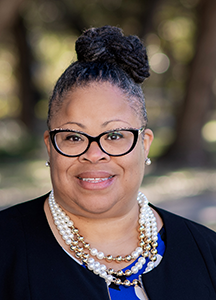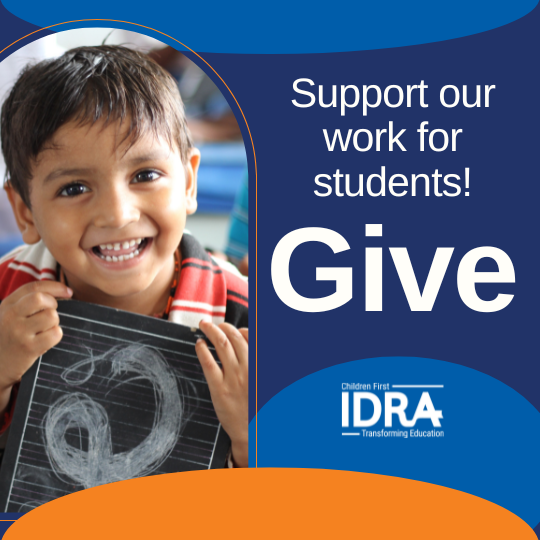• Dr. Paula Johnson • IDRA Newsletter • March 2022 •
Our goal as educators, parents and community members is to provide the best for the next generation. We make decisions with the best intentions. From conception on, there are a million choices that influence a student’s life. Some are minor. Some are huge. Take a moment to consider how many of them are informed by the students themselves. Our youth are telling us what they want and what they need. It is time that we listen. 
Teachers spend years engaging students through strategies like cooperative working groups, turn and talks, and think-pair-shares, that give students the opportunity to talk in small settings. We teach them to give input in class discussions. Students learn the art of negotiation in speech through persuasive arguments. Students have ongoing chances for developing self-advocacy as they grow.
At home, they navigate the joys of the teenage years by preparing arguments for securing later bedtimes, getting the newest phones or earning the privilege of going out with friends. To support independent thinking and selection processing when children are small, parents and teachers offer several opportunities for students to make their own choices. We let them pick out their clothes, which book to read or which activity to participate in. We offer choices and give them space to decide.
Critical thinking, problem solving and solution making are highly encouraged skills in education. Classrooms across the globe promote the development of these abilities through a variety of strategies, including student dialogue, persuasive writing and debate.
But our current social climate is exposing a large number of adults who lean more toward a “children should be seen and not heard” attitude. It seems that when marginalized, underserved and underrepresented youth do speak out about controversial issues, pedagogy plans and real-life practice begin to diverge. Youth face opposition when what they have to say is not in alignment with the adults making the decisions.
How can we raise the next generation to think for themselves if we oppose them when it is most critical? Instead, we should be amplifying these voices that have something to say, but don’t have access to the microphone (IDRA, 2021). It’s their future! We should want their input. The only way to ensure that the next generation achieves educational justice and equity is to let them contribute to the goals and objectives that will impact them most.
Alexandria City Public Schools’ Equity for All 2025 campaign in Virginia focuses on racial equity. In 2020, Superintendent Dr. Gregory C. Hutchings and the district launched a strategic plan where equity is at the center of all they do. The district believes that racial equity will be achieved “when race does not determine quality of life, opportunities and outcomes” (2020).
By placing equity as a pillar of the community, leaders sought out and amplified voices from across the district. Teachers, students, families and members from the entire city of Alexandria engaged in the planning process. The district formed multiple citywide partnerships to support students’ social, emotional and academic needs and to encourage their advocacy for social change.
Another conversation that students are weighing in on involves a disheartening nationwide attack on books that focus on race, gender and sexuality (Latham Sikes, 2022). Loud politicians, parents and activists are weaponizing legislation to censor a growing list of books they have labeled “pornographic,” “divisive” or “incendiary,” books that largely target LGBTQ authors and texts, as well as books on race and racism. Students turn to these books to gain new perspectives and to see the world through others’ experiences to seek affirmation of their own experiences. When people attack these books, their authors or the subject matter, they are preventing any possibility for necessary conversations. They are essentially cultivating a climate for increased bullying, harassment and violence. We are in dire need of many more courageous and critical conversations to address the needs of our students, families and communities.
Substantive conversations help students develop and evaluate arguments and evidence in support from different points of view (Carter Andrews, et al., 2018). Unfortunately, many teachers are ill-equipped to lead discussions on sensitive subject matters like racism and sexual identity. Teacher preparation programs must provide future teachers with the tools to “cultivate school and classroom culture and climate that emanate humanity, dignity and respect for all” (Carter Andrews, et al., 2018).
In Pedagogy of the Oppressed, Freire says, “Education either functions as an instrument which is used to facilitate integration of the younger generation into the logic of the present system and bring about conformity or it becomes the practice of freedom.” Furthermore, when education is a catalyst for freedom, “men and women deal critically and creatively with reality and discover how to participate in the transformation of their world.” (Freire, 2000)
Representation matters. Those who truly believe this invite students as thought partners. Who better to help us determine the next steps toward their future? Students belong in focus groups. Youth representatives should be part of every district and campus equity and diversity planning committee. Student leaders should be consulted on every decision that has the potential to impact their lives. Youth are the voice of the people. The only way to know if we are on the right path is to ask the ones for which the destination is planned.
This is not the first time that youth are leading the charge for freedom. For example, the Student Nonviolent Coordinating Committee (SNCC, pronounced “snick”) was one of the key organizations during the Civil Rights Movement of the 1960s. SNCC members, mostly college students, were integral in the March on Washington, sit-ins, Freedom Rides and multiple voter education projects. Based in Georgia, these young leaders fought to end segregation and advance social equality.
Our youth leaders of today are a growing force that we must uplift if we ever hope to achieve these goals. The SNCC Legacy Project (SLP) is alive and well today. Its mission statement declares: “Built into our efforts is the determination to see that our legacy, the legacy of the freedom struggle, is passed from our generation to future generations. A Luta Continua! (The struggle continues!)” (2022).
Resources
Alexandria City P.S. (2020). Equity for All 2025: Strategic Plan 2020-2025. Alexandria City Public Schools, Virginia.
Betancourt, V., Johnson, P., & Montemayor, A. (October 2013). Substantive Conversation in the Classroom – Podcast Episode 130. IDRA Classnotes Podcast.
Carter Andrews, D.J., Richmond, G., Warren, C.A., Petchauer, E., & Floden, R. (May 2018). A Call to Action for Teacher Preparation Programs: Supporting Critical Conversations and Democratic Action in Safe Learning Environments. Journal of Teacher Education, 69(3), 205-208.
Freire, P. (2000). Pedagogy of the Oppressed (30th Anniversary ed.). Continuum.
IDRA. (2021). Students Tell Texas Attorney General that Racial Discrimination in School is Real – IDRA Applauds Students Speaking Out Against Texas’ New Classroom Censorship Law. Knowledge is Power.
Johnson, P. (May 2016). The Role of Conversation in the Classroom – Promoting Student Voice through Instructional Dialogue. IDRA Newsletter.
Johnson, P. (May 2015). The Role of Conversation – Engaging Students in Critical Thinking through Dialogue. IDRA Newsletter.
Latham Sikes, C. (November 18, 2021). Show Us Your… Books? The Latest Texas Efforts to Censor Classrooms. Knowledge is Power.
NCSS. (2022). Student Nonviolent Coordinating Committee (SNCC) Legacy Project, website.
Paula N. Johnson, Ph.D., is an IDRA education associate and director of the IDRA EAC-South. Comments and questions may be directed to her via email at paula.johnson@idra.org.
[©2022, IDRA. This article originally appeared in the March 2022 IDRA Newsletter by the Intercultural Development Research Association. Permission to reproduce this article is granted provided the article is reprinted in its entirety and proper credit is given to IDRA and the author.]



